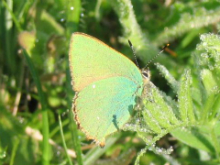
Very rare and restricted

Distribution and Status
The Green Hairstreak is rare in the two counties and is mostly found on calcareous grassland and heaths such as Hexton Chalk Pit, Aldbury Nowers and the Tring Park area. In the last few years, colonies have been discovered in south-western Middlesex, like Hounslow Heath. Reports of sightings on at least two new sites were received in 2019 including Waterford Heath and Dartmouth Park, east of Hampstead Heath. In 2021 there were reports from Alexandra Park, Heartwood Forest and Bushy Park. In 2023, sightings were reported from the eastern side of Middlesex, at Trent Park and Tower Hamlets Cemetery Park. It does not appear to exist in open areas in woodland like it did in the past

Habitat Requirements
Unimproved grassland, heaths, railway banks, and woodland rides but scrubby plants or hedgerows must be present
Larval Foodplants
Common Rock-rose Helianthemum nummularium, Broom Cytisus scoparius, Dyer's Greenweed Genista tinctoria, Gorse Ulex spp., Common Bird's-foot Trefoil Lotus corniculatus on chalk. [Greater Bird's-foot Trefoil L. pedunculatus, Dogwood Cornus sanguinea, Purging Buckthorn Rhamnus catharticus, Bramble Rubus fruticosus]
Adult Food Sources
Goat Willow Salix cinerea, Bluebell Hyacinthoides non-scripta, Common Bird's-foot Trefoil Lotus corniculatus
Behaviour/Observation notes
Males take up territories around shrubs like hawthorn, in search for females or to chase off rival males. Females tend to fly close to the ground
Life History
Only one generation is produced each year with most specimens emerging in May. Eggs are laid singly on the foodplant and hatch after about ten days. Larvae begin by feeding in buds then the leaves as they grow. Pupae are formed on the ground, often in ants' nests. The ants being attracted by the pupae are thought to carry them to the nests. The winter is spent in the pupal stage

Further information
Photo gallery
Branch Annual Report (2023)
More on life cycle and status
UK distribution map
Full list of larval hostplants (Lycaenidae)
Stevenage butterflies - additional notes
Account for 2022